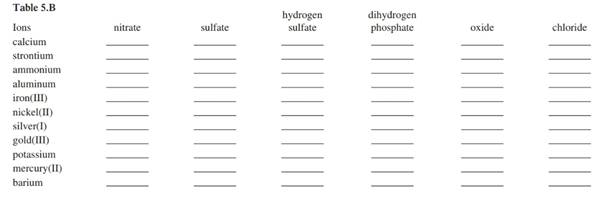
For each of the negative ions listed in column 1, use the periodic table to find in column 2 the total number of electrons the ioncontains. A given answer may be used more than once.
| Column 1 |
Column 2 |
| [ 1] |


Want to see the full answer?
Check out a sample textbook solution
Chapter 5 Solutions
Introductory Chemistry: A Foundation
- Write the electron configurations for each of the following elements and its 3+ ions: (a) La (b) Sm (c) Luarrow_forwardDetermine the charge of each of the following: a silver atom that has lost one electron a bromine atom that has gained one electron a chromium atom that has lost three electronsarrow_forwardWhich ion with a +1 charge has the electron configuration 1s22s22p63s23p63d104s24p6? Which ion with a —2 charge has this configuration?arrow_forward
- For the following questions, circle the correct answer. Which of the following is arranged in order of the increasing ionization energy? Sn<Te<Sb<In C<Si<Ge<Sn Rb<Sr<In<Sn Te<Sb<Sn<Inarrow_forwardOut of these ions Li1+ Mg2+ Br-1 Te2- Which ion has the largest radius?arrow_forwardEach of the following sets contains isoelectronic ions (ions containing the same number of electrons). Select the set that shows the correct trend in increasing size or increasing ionic radius. (A) O2– < F– < Na+ < Mg2+ ; (B) F– < O2– < Mg2+ < Na+; (C) Mg2+ < Na+ < F– < O2–; (D) Mg2+ < Na+ < F– < O2–;arrow_forward
- A neutral atom of aluminum has 14 neutrons and 13 protons. How many electrons does this aluminum have? a 1 b 13 c 14 d 27 The number of protons in the nucleus of an atom determines the species of the atom, i.e., the element to which the atom belongs. An atom has the same number of protons and neutrons. But the electron number cannot be used instead because a electrons are not within the nucleus b electrons are negatively charged c electrons can be removed from or added to an atom d electrons are lighter than protonsarrow_forwardlook at the table "Model 1" to see the "Lewis Dot Diagrams" of elements in the Periodic table. How many "Valence Electrons" do elements from: 1a) Main Group 1 (H, Li, Na) 1b) Main group 3 (B, Al) 1c) Main Group 7 (F, Cl, Br) Based on how you answered Question 1, how could you tell the amount of "Valence Electrons" an element has from looking at the periodic table?arrow_forwardPlace these atoms in the order of increasing atomic radii: Ca, Mg, P, and Cl.a. Cl < P < Mg < Cab. Mg < P < Cl < Cac. Ca < Mg < P < Cld. P < Cl < Mg < Cae. Ca < Cl < P < Mgarrow_forward
- Answer the following questions about the macronutrients calcium, magnesium, and sulfur. a. Is each element classifi ed as a metal, nonmetal, or metalloid? b. In which block does each element reside? c. Which element has the smallest atomic radius? d. Which element has the largest atomic radius? e. Which element has the largest ionization energy? f. Which element has the smallest ionization energy? g. How many valence electrons does each element possess?Answer the following questions about the macronutrients calcium, magnesium, and sulfur. a. Is each element classifi ed as a metal, nonmetal, or metalloid? b. In which block does each element reside? c. Which element has the smallest atomic radius? d. Which element has the largest atomic radius? e. Which element has the largest ionization energy? f. Which element has the smallest ionization energy? g. How many valence electrons does each element possess?arrow_forwardWhich ions have the same number of electrons as an atom of krypton Se^2- As^3- Ca^2+ K+ Which element is most likely to form a monatomic ion with 3- charge S P Be Alarrow_forwardUse the table below to Answer the question.magnesium ionization energy greatly increased after the second ionization energy. What is the reason for the great jumó in ionization energy. Which one these multiple choice is the awnser below 1. Magnesium has two valence electrons and both are being removed at the same time. 2. Magnesium has two valence electrons and when both are removed the atom has full valence shell . 3. Magnesium has 3 valence electrons and both are being removed at the same time . 4. Magnesium has two valence electrons and does not like to give the valence electronsarrow_forward
 Introductory Chemistry: A FoundationChemistryISBN:9781337399425Author:Steven S. Zumdahl, Donald J. DeCostePublisher:Cengage Learning
Introductory Chemistry: A FoundationChemistryISBN:9781337399425Author:Steven S. Zumdahl, Donald J. DeCostePublisher:Cengage Learning World of Chemistry, 3rd editionChemistryISBN:9781133109655Author:Steven S. Zumdahl, Susan L. Zumdahl, Donald J. DeCostePublisher:Brooks / Cole / Cengage Learning
World of Chemistry, 3rd editionChemistryISBN:9781133109655Author:Steven S. Zumdahl, Susan L. Zumdahl, Donald J. DeCostePublisher:Brooks / Cole / Cengage Learning
- Chemistry: Matter and ChangeChemistryISBN:9780078746376Author:Dinah Zike, Laurel Dingrando, Nicholas Hainen, Cheryl WistromPublisher:Glencoe/McGraw-Hill School Pub Co
 General, Organic, and Biological ChemistryChemistryISBN:9781285853918Author:H. Stephen StokerPublisher:Cengage Learning
General, Organic, and Biological ChemistryChemistryISBN:9781285853918Author:H. Stephen StokerPublisher:Cengage Learning Chemistry by OpenStax (2015-05-04)ChemistryISBN:9781938168390Author:Klaus Theopold, Richard H Langley, Paul Flowers, William R. Robinson, Mark BlaserPublisher:OpenStax
Chemistry by OpenStax (2015-05-04)ChemistryISBN:9781938168390Author:Klaus Theopold, Richard H Langley, Paul Flowers, William R. Robinson, Mark BlaserPublisher:OpenStax





